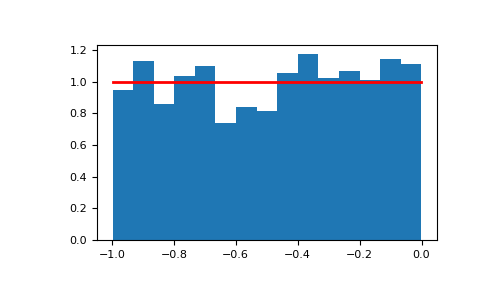numpy.random.Generator.uniform¶
method
- random.Generator.uniform(low=0.0, high=1.0, size=None)¶
Draw samples from a uniform distribution.
Samples are uniformly distributed over the half-open interval
[low, high)(includes low, but excludes high). In other words, any value within the given interval is equally likely to be drawn byuniform.- Parameters
- lowfloat or array_like of floats, optional
Lower boundary of the output interval. All values generated will be greater than or equal to low. The default value is 0.
- highfloat or array_like of floats
Upper boundary of the output interval. All values generated will be less than high. high - low must be non-negative. The default value is 1.0.
- sizeint or tuple of ints, optional
Output shape. If the given shape is, e.g.,
(m, n, k), thenm * n * ksamples are drawn. If size isNone(default), a single value is returned iflowandhighare both scalars. Otherwise,np.broadcast(low, high).sizesamples are drawn.
- Returns
- outndarray or scalar
Drawn samples from the parameterized uniform distribution.
See also
Notes
The probability density function of the uniform distribution is
\[p(x) = \frac{1}{b - a}\]anywhere within the interval
[a, b), and zero elsewhere.When
high==low, values oflowwill be returned.Examples
Draw samples from the distribution:
>>> s = np.random.default_rng().uniform(-1,0,1000)
All values are within the given interval:
>>> np.all(s >= -1) True >>> np.all(s < 0) True
Display the histogram of the samples, along with the probability density function:
>>> import matplotlib.pyplot as plt >>> count, bins, ignored = plt.hist(s, 15, density=True) >>> plt.plot(bins, np.ones_like(bins), linewidth=2, color='r') >>> plt.show()
